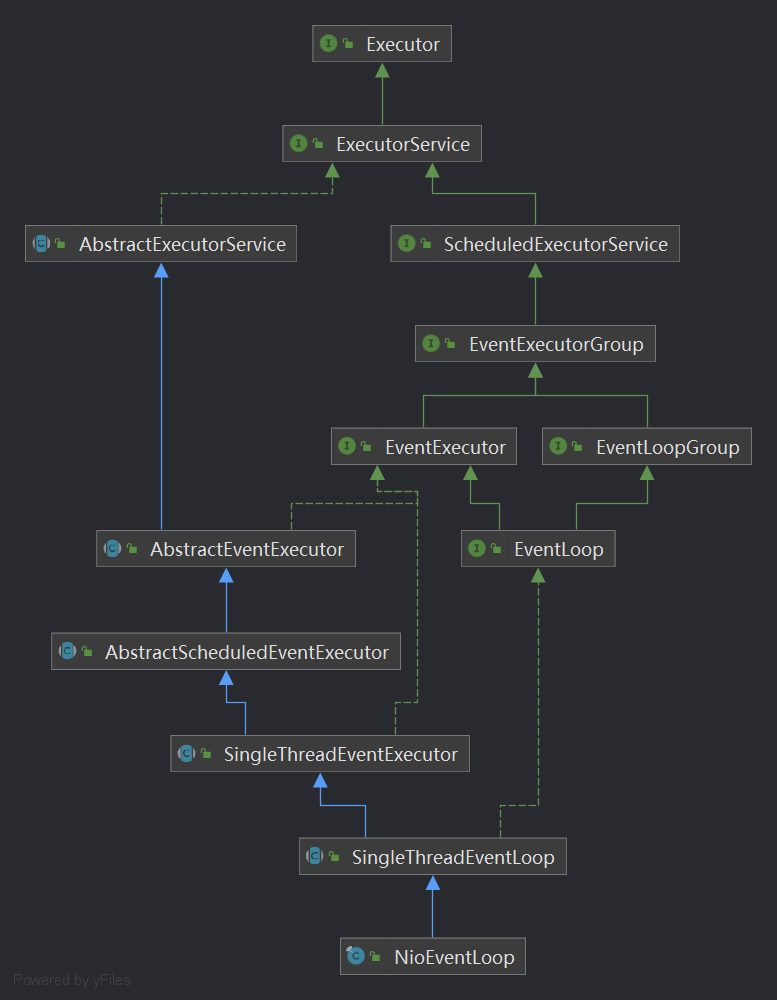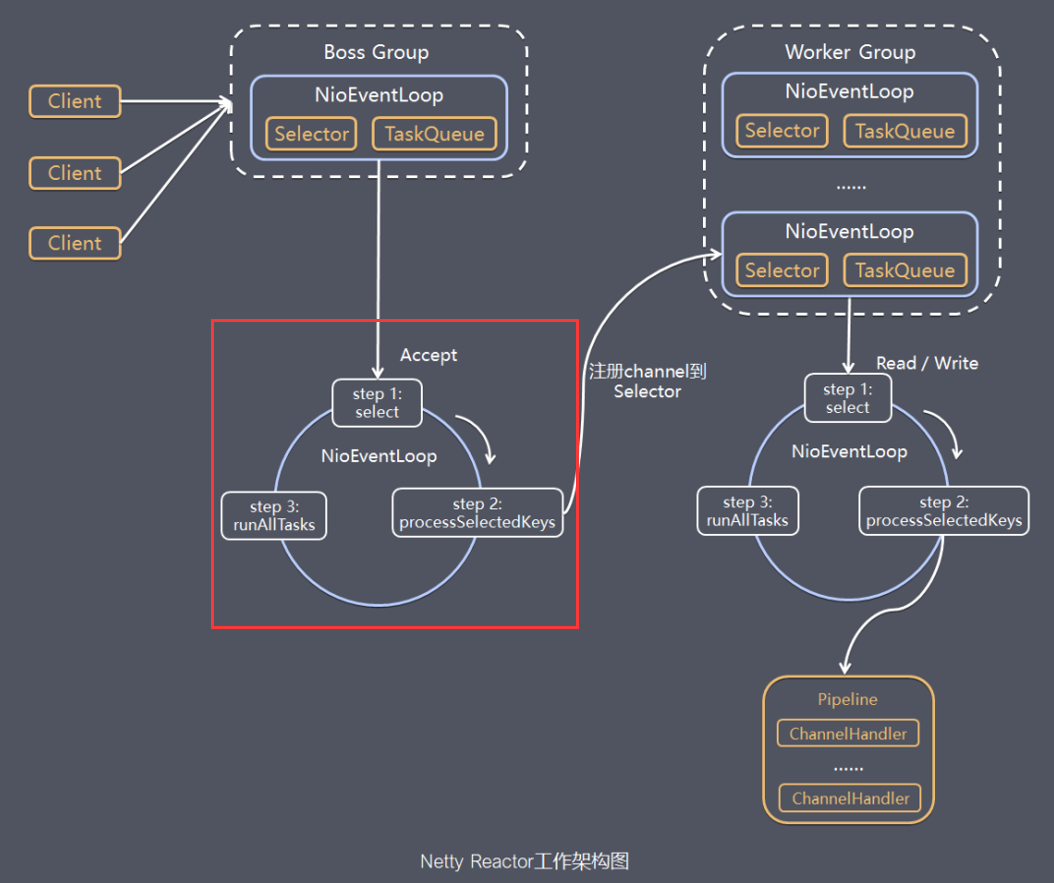先看看EventLoop类图

我们在Netty第二篇文章中的代码中,看到有多次用到eventLoop.execute()方法,这个方法就是EventLoop开启线程执行任务的关键,跟踪进去看看
// 类SingleThreadEventExecutor
SingleThreadEventExecutor#execute(Runnable task)
-->
SingleThreadEventExecutor#execute0(@Schedule Runnable task)
-->
private void execute(Runnable task, boolean immediate) {
// 判断当前线程是否为eventLoop的线程
boolean inEventLoop = inEventLoop();
// 将任务添加进taskQueue
addTask(task);
if (!inEventLoop) {
// 开启eventLoop的线程
startThread();
if (isShutdown()) {
boolean reject = false;
try {
if (removeTask(task)) {
reject = true;
}
} catch (UnsupportedOperationException e) {
// The task queue does not support removal so the best thing we can do is to just move on and
// hope we will be able to pick-up the task before its completely terminated.
// In worst case we will log on termination.
}
if (reject) {
reject();
}
}
}
if (!addTaskWakesUp && immediate) {
wakeup(inEventLoop);
}
}这段代码,我们分3部分解读
添加任务
将任务添加进队列,等待调用
对应代码
// addTask(task);
// 类SingleThreadEventExecutor
protected void addTask(Runnable task) {
ObjectUtil.checkNotNull(task, "task");
// 添加任务
if (!offerTask(task)) {
// 如果添加失败,执行拒绝执行处理器
reject(task);
}
}SingleThreadEventExecutor有一个类变量来存储task
private final Queue<Runnable> taskQueue;开启线程
开启线程是以下这段逻辑
// 判断当前线程是否eventLoop的线程
// 如果不是,则开启EventLoop的线程
if (!inEventLoop) {
// 开启eventLoop的线程
startThread();
。。。。。。
}
-->
// 类SingleThreadEventExecutor
private void startThread() {
// 一些状态判断,保证doStartThread只会被执行一次
if (state == ST_NOT_STARTED) {
// cas修改状态
if (STATE_UPDATER.compareAndSet(this, ST_NOT_STARTED, ST_STARTED)) {
boolean success = false;
try {
// 实际开启线程的方法
doStartThread();
success = true;
} finally {
if (!success) {
STATE_UPDATER.compareAndSet(this, ST_STARTED, ST_NOT_STARTED);
}
}
}
}
}
-->
// 类SingleThreadEventExecutor
private void doStartThread() {
assert thread == null;
// 这个Executor在EventLoopGroup构造时,就已经注入
// MultithreadEventExecutorGroup
// executor = new ThreadPerTaskExecutor(newDefaultThreadFactory());
executor.execute(new Runnable() {
@Override
public void run() {
thread = Thread.currentThread();
if (interrupted) {
thread.interrupt();
}
boolean success = false;
updateLastExecutionTime();
try {
// 这个整个NioEventLoop的核心,里面是个死循环
SingleThreadEventExecutor.this.run();
success = true;
} catch (Throwable t) {
logger.warn("Unexpected exception from an event executor: ", t);
} finally {
。。。。。。
}
}
});
}在前面EventLoopGroup的创建与初始化一节有说到,executor的实例化
executor = new ThreadPerTaskExecutor(newDefaultThreadFactory());
executor.execute(new Runnable() {...});
// 不深究细节的话,上面两行代码效果类比下面两行
Thread thread = new Thread(new Runnable() {...});
thread.start();所以,executor.execute这里,就开了一个新的线程。
而这个线程,主要处理的是SingleThreadEventExecutor.**this**.run();,也就是NioEventLoop#run()
那这个run方法是干嘛的,看下图红框部分

因为run方法比较重要,此处不做代码省略,看注释
protected void run() {
int selectCnt = 0;
for (;;) {
try {
int strategy;
try {
// 如果没有任务,则返回SELECT
// 有任务,则获取io事件的个数。此时如果strategy >= 0
// 如果有io任务,优先io任务,然后才执行普通任务
strategy = selectStrategy.calculateStrategy(selectNowSupplier, hasTasks());
switch (strategy) {
case SelectStrategy.CONTINUE:
continue;
case SelectStrategy.BUSY_WAIT:
// fall-through to SELECT since the busy-wait is not supported with NIO
case SelectStrategy.SELECT:
// 下一次定时任务触发截止时间
long curDeadlineNanos = nextScheduledTaskDeadlineNanos();
if (curDeadlineNanos == -1L) {
curDeadlineNanos = NONE; // nothing on the calendar
}
nextWakeupNanos.set(curDeadlineNanos);
try {
// 再次判断没有任务
if (!hasTasks()) {
strategy = select(curDeadlineNanos);
}
} finally {
// This update is just to help block unnecessary selector wakeups
// so use of lazySet is ok (no race condition)
// 阻止不必要的唤醒
nextWakeupNanos.lazySet(AWAKE);
}
// fall through
default:
}
} catch (IOException e) {
// If we receive an IOException here its because the Selector is messed up. Let's rebuild
// the selector and retry. https://github.com/netty/netty/issues/8566
rebuildSelector0();
selectCnt = 0;
handleLoopException(e);
continue;
}
selectCnt++;
cancelledKeys = 0;
needsToSelectAgain = false;
// 控制处理io事件的事件占用比例,默认是百分之50,一半时间用来处理io事件,一半时间用来处理任务
final int ioRatio = this.ioRatio;
boolean ranTasks;
// 100%表示执行完全部任务,才进入下一轮循环
if (ioRatio == 100) {
try {
if (strategy > 0) {
// 在对应的 Channel 上处理 IO 事件
processSelectedKeys();
}
} finally {
// Ensure we always run tasks.
// 执行queueTask中全部的任务
ranTasks = runAllTasks();
}
} else if (strategy > 0) {
final long ioStartTime = System.nanoTime();
try {
// 在对应的 Channel 上处理 IO 事件
processSelectedKeys();
} finally {
// Ensure we always run tasks.
final long ioTime = System.nanoTime() - ioStartTime;
ranTasks = runAllTasks(ioTime * (100 - ioRatio) / ioRatio);
}
} else {
// 0表示运行运行最小数量的任务,即63个
ranTasks = runAllTasks(0); // This will run the minimum number of tasks
}
if (ranTasks || strategy > 0) {
if (selectCnt > MIN_PREMATURE_SELECTOR_RETURNS && logger.isDebugEnabled()) {
logger.debug("Selector.select() returned prematurely {} times in a row for Selector {}.",
selectCnt - 1, selector);
}
selectCnt = 0;
} else if (unexpectedSelectorWakeup(selectCnt)) { // Unexpected wakeup (unusual case)
selectCnt = 0;
}
} catch (CancelledKeyException e) {
// Harmless exception - log anyway
if (logger.isDebugEnabled()) {
logger.debug(CancelledKeyException.class.getSimpleName() + " raised by a Selector {} - JDK bug?",
selector, e);
}
} catch (Error e) {
throw e;
} catch (Throwable t) {
handleLoopException(t);
} finally {
// Always handle shutdown even if the loop processing threw an exception.
try {
if (isShuttingDown()) {
closeAll();
if (confirmShutdown()) {
return;
}
}
} catch (Error e) {
throw e;
} catch (Throwable t) {
handleLoopException(t);
}
}
}
}run里面是个死循环,关键方法有select、processSelectedKeys、runAllTasks
-
select
select方法很简单,就是选择合适的阻塞时间,等待IO事件触发
private int select(long deadlineNanos) throws IOException { if (deadlineNanos == NONE) { return selector.select(); } // Timeout will only be 0 if deadline is within 5 microsecs // 如果deadlineNanos小于5纳秒,则为0,,否则取整为1毫秒 // 这段操作是为了向上取整,转成毫秒 long timeoutMillis = deadlineToDelayNanos(deadlineNanos + 995000L) / 1000000L; // 如果timeoutMillis大于0,就阻塞selector同样的时间 // 这段是为了获取最近的延时任务 return timeoutMillis <= 0 ? selector.selectNow() : selector.select(timeoutMillis); } -
runAllTasks
此方法会取出可执行的任务,并执行。
上一节添加任务讲的addTask,放入的任务就是在这里被执行的。
-
processSelectedKeys
此方法在有IO事件时才触发,这个下面细讲
小结一下,run的死循环中主要判断有无IO事件,有则处理,处理完IO事件,再处理队列中的任务。
如果没有IO事件,也没有待处理的任务,则阻塞等待。
唤醒线程
对应代码
// wakeup(inEventLoop);
// 类NioEventLoop
protected void wakeup(boolean inEventLoop) {
// 不是当前EventLoop在执行的时候,才需要唤醒
// nextWakeupNanos放入AWAKE是阻止不必要的唤醒
if (!inEventLoop && nextWakeupNanos.getAndSet(AWAKE) != AWAKE) {
selector.wakeup();
}
}阻塞是selecto.select,那么唤醒就是selector.wakeup